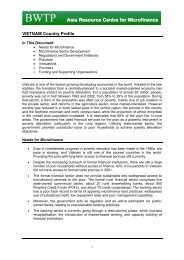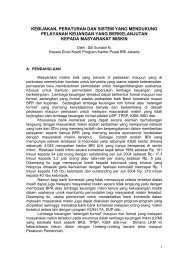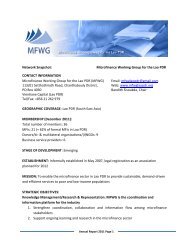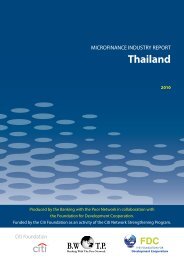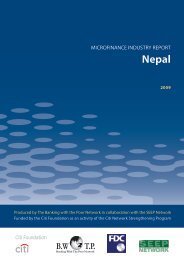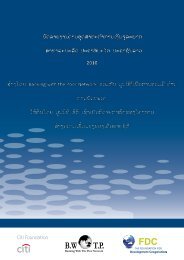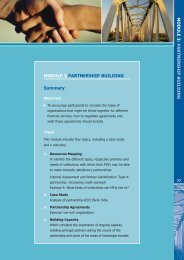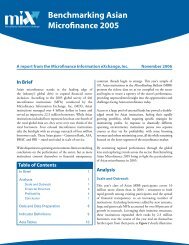Micro Finance in India - Banking with the Poor Network
Micro Finance in India - Banking with the Poor Network
Micro Finance in India - Banking with the Poor Network
Create successful ePaper yourself
Turn your PDF publications into a flip-book with our unique Google optimized e-Paper software.
B A S I X :--- The Papers & Publications<br />
http://www.basix<strong>in</strong>dia.com/micro_f<strong>in</strong>ance_<strong>in</strong>_<strong>in</strong>dia.htm<br />
Page 3 of 10<br />
27/08/03<br />
better bank<strong>in</strong>g facilities, as shown by <strong>the</strong> experience of <strong>the</strong> SEWA Bank, Ahmedabad. The poor want<br />
to save for various reasons – as a cushion aga<strong>in</strong>st cont<strong>in</strong>gencies like illness, calamities, death <strong>in</strong> <strong>the</strong><br />
family, etc; as a source of equity or marg<strong>in</strong> to take loans; and f<strong>in</strong>ally, as a liquid asset. The safety of<br />
sav<strong>in</strong>gs is of higher concern than <strong>in</strong>terest rates. The demand for sav<strong>in</strong>gs services is high <strong>in</strong> rural areas<br />
as well, as can be seen from a recent study of women’s sav<strong>in</strong>gs and credit movement <strong>in</strong> Andhra<br />
Pradesh. Almost all women’s groups <strong>in</strong> <strong>the</strong>ir early years beg<strong>in</strong> <strong>with</strong> regular sav<strong>in</strong>gs and <strong>the</strong>ir sav<strong>in</strong>gs<br />
exceed <strong>the</strong> loans <strong>the</strong>y give from <strong>the</strong>ir funds. Of course, part of this lower demand for credit is <strong>the</strong><br />
<strong>in</strong>adequate absorption capacity of women, which comes from long years of exclusion from <strong>the</strong><br />
economic sphere outside <strong>the</strong>ir homes.<br />
The demand for <strong>in</strong>surance services, though not very well articulated, is also substantial. This comes<br />
from <strong>the</strong> fact that not only <strong>in</strong>comes of microf<strong>in</strong>ance customers low, but are also highly variable.<br />
Insurance by <strong>the</strong> poor is needed for assets such as livestock and pumpsets, for shelter. Crop <strong>in</strong>surance<br />
could be very useful to <strong>the</strong> rural poor. F<strong>in</strong>ally, <strong>in</strong>surance aga<strong>in</strong>st illness, disability and death would also<br />
reduce <strong>the</strong> shocks caused by such cont<strong>in</strong>gencies, which lead <strong>the</strong> poor <strong>in</strong>to tak<strong>in</strong>g loans at such times<br />
at high <strong>in</strong>terest.<br />
3.Supply of <strong>Micro</strong>-<strong>F<strong>in</strong>ance</strong> Services<br />
RBI data shows that <strong>in</strong>formal sources provide a significant part of <strong>the</strong> total credit needs of <strong>the</strong> rural<br />
population. The magnitude of <strong>the</strong> dependence of <strong>the</strong> rural poor on <strong>in</strong>formal sources of credit can be<br />
observed from <strong>the</strong> f<strong>in</strong>d<strong>in</strong>gs of <strong>the</strong> All <strong>India</strong> Debt and Investment Survey, 1992, which shows that <strong>the</strong><br />
share of <strong>the</strong> non-<strong>in</strong>stitutional agencies (<strong>in</strong>formal sector) <strong>in</strong> <strong>the</strong> outstand<strong>in</strong>g cash dues of <strong>the</strong> rural<br />
households was 36 percent. However, <strong>the</strong> dependence of rural households on such <strong>in</strong>formal sources<br />
had reduced of <strong>the</strong>ir total outstand<strong>in</strong>g dues steadily from 83.7 percent <strong>in</strong> 1961 to 36 percent <strong>in</strong> 1991.<br />
This is shown <strong>in</strong> <strong>the</strong> table below.<br />
Outstand<strong>in</strong>gs from Informal Sources as a Percentage of Total Dues,<br />
for Various Occupational Categories of Rural Households<br />
Year Cultivators Non-Cultivators All<br />
1961 81.6 89.5 83.7<br />
1971 60.3 89.2 70.8<br />
1981 36.8 63.3 38.8<br />
1991 33.7 44.7 36.0<br />
Among formal <strong>in</strong>stitutional sources, banks and co-operatives provided credit support to almost 56<br />
percent of <strong>the</strong> rural households, while professional and agricultural money lenders were provid<strong>in</strong>g<br />
credit to almost one sixth of <strong>the</strong> rural households. The details by source are given below:<br />
Sources of Credit for Rural Households, 1991<br />
Credit Agency<br />
% of Rural Households<br />
Government etc 6.1<br />
Cooperative Societies 21.6<br />
Commercial Banks and RRBs 33.7



